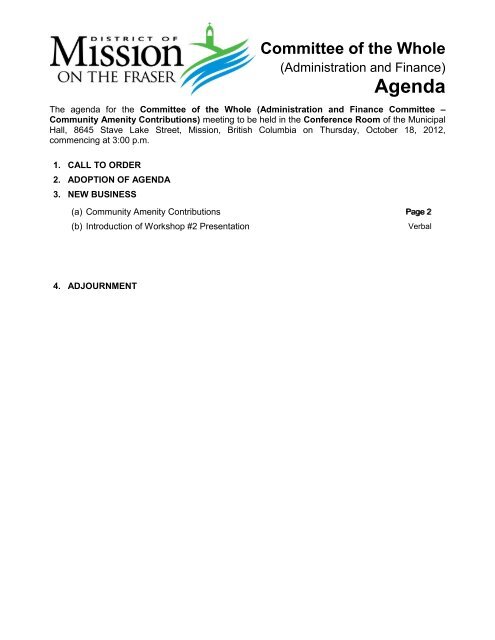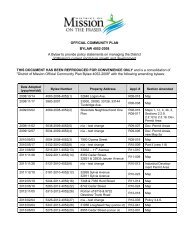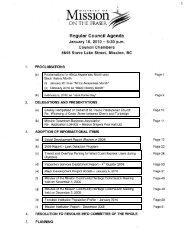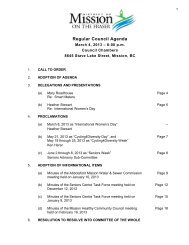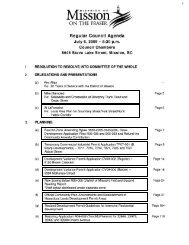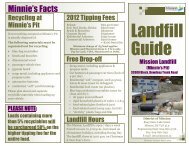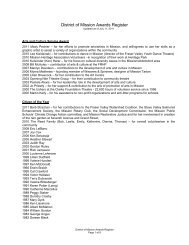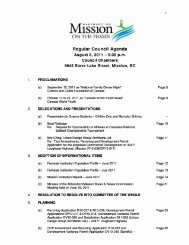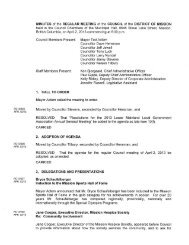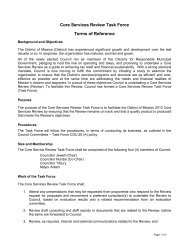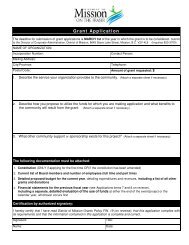October 18, 2012 Administration & Finance - District of Mission
October 18, 2012 Administration & Finance - District of Mission
October 18, 2012 Administration & Finance - District of Mission
Create successful ePaper yourself
Turn your PDF publications into a flip-book with our unique Google optimized e-Paper software.
Committee <strong>of</strong> the Whole(<strong>Administration</strong> and <strong>Finance</strong>)AgendaThe agenda for the Committee <strong>of</strong> the Whole (<strong>Administration</strong> and <strong>Finance</strong> Committee –Community Amenity Contributions) meeting to be held in the Conference Room <strong>of</strong> the MunicipalHall, 8645 Stave Lake Street, <strong>Mission</strong>, British Columbia on Thursday, <strong>October</strong> <strong>18</strong>, <strong>2012</strong>,commencing at 3:00 p.m.1. CALL TO ORDER2. ADOPTION OF AGENDA3. NEW BUSINESS(a) Community Amenity Contributions Page 2(b) Introduction <strong>of</strong> Workshop #2 PresentationVerbal4. ADJOURNMENT
2Development ServicesStaff Report to CouncilFile Category:File Folder:FIN.COM.REPCommunity Amenity Workshop Content SummaryDATE: <strong>October</strong> <strong>18</strong>, <strong>2012</strong>TO:FROM:SUBJECT:Mayor and CouncilSharon Fletcher, Director <strong>of</strong> Long Range Planning and Special Projects, andMike Younie, Director <strong>of</strong> Development ServicesCommunity Amenity ContributionsATTACHMENT(S): Appendix 1 - LAN 40 Financial Contributions for Community Amenity PolicyAppendix 2 - Excerpt from the Coriolis Report dated 2007, pages 7-12 – BasicApproaches to Obtaining Amenity ContributionsAppendix 3 - Summary <strong>of</strong> Methods for Determining the Amount <strong>of</strong> a CommunityAmenity ContributionAppendix 4 - City <strong>of</strong> Richmond Survey <strong>of</strong> Community Amenity ContributionApproaches in Metro Vancouver MunicipalitiesRECOMMENDATION(S):1) That the value based method (a per residential unit contribution calculated by dividing aproportionate cost <strong>of</strong> defined amenity projects by estimated residential growth over a set period<strong>of</strong> time) be used for calculating community amenity contributions, as a consistent approach forresidential developments regardless <strong>of</strong> the size <strong>of</strong> the application; and2) That a formal negotiation approach, based on calculating the land-lift value, be included in thedraft community amenity policy , as an option for establishing community amenity contributionsin certain circumstances, e.g. for significant multi-use or commercial developments.EXECUTIVE SUMMARY:The workshop will result in:• A common understanding <strong>of</strong> community amenity contributions; and• Confirmation <strong>of</strong> the mechanism(s) used to calculate and collect community amenity contributions.It is recommended that the current value based method continue to be used for residential developmentsince it:• Fairly distributes the contribution to all residential development rezoning applications;• Can be resourced entirely by the <strong>District</strong>;• Provides assurance <strong>of</strong> the amount, and therefore, reduces the risk caused by uncertainty todevelopers; and• Enables the <strong>District</strong> to estimate when and how much revenue will be available when an amenityis needed while providing flexibility for which amenity will come on-line.Page 1 <strong>of</strong> 21
3It is also recommended that the policy include the option for the <strong>District</strong> to enter into a formal negotiationprocess with developers regarding community amenity contributions for significant developments.Workshop #2 (to be held on November 6, <strong>2012</strong>) will focus on the proposed amenities identified by thecommunity, the feedback the community has already provided and confirmation <strong>of</strong> the list <strong>of</strong> communityamenities.PURPOSE:The purpose <strong>of</strong> the community amenity workshops are to:1. inform Council <strong>of</strong> the different approaches and complexities associated with community amenitiesand to review <strong>Mission</strong>’s current approach, the legal and legislative perspectives, and the reviewprocess undertaken to date around community amenities;2. agree on <strong>Mission</strong>’s future approach for collecting community amenities; and3. finalize the list <strong>of</strong> amenities and the related share <strong>of</strong> each amenity that would be paid for bydevelopers versus existing residents or taxpayers (workshop #2).BACKGROUNDThis report draws on information contained within the following reports:o The Coriolis Consulting report for the City <strong>of</strong> Victoria (2007) (excerpt attached as Appendix 2);ando The City <strong>of</strong> New Westminster staff report (2005) and the Coriolis Consulting report (2005).1. RationaleWhy are amenities important?• Community amenities make communities better places to live. Without amenities, a community isjust a place to sleep, shop and work. Amenities are <strong>of</strong>ten regarded as facilities that are neededas a result <strong>of</strong> growth and the pleasant features that make for a complete community;• The existence <strong>of</strong> amenities are <strong>of</strong>ten used by community leaders, businesses and realtors to sellthe community as a preferred place to do business or to buy a house and raise a family – a placewith parks and trails, a library, places to meet people or play sports, etc.; and• Amenities can and do attract development.What are the legislative and legal bases for having a Community Amenity Policy?• Community amenity contributions can only be volunteered through the rezoning process;• Community amenities cannot be financed through Development Cost Charges (DCCs);• DCCs are restricted by legislation to specific types <strong>of</strong> core infrastructure or improvements such aswater, sewer, drainage, roads, and specific park land projects (e.g. Silvercreek Parkway andenvironmentally sensitive areas in Cedar Valley); and• The only other practical funding sources for amenity projects are capital funding from general taxrevenue or borrowing that would have to be paid for from general revenue. Most <strong>of</strong> <strong>Mission</strong>’sgeneral tax revenue is needed to cover operating costs and base infrastructure, and there arereal limitations on how much the taxpayer can afford.STAFF REPORT TO COUNCIL Page 2 <strong>of</strong> 21
4What approach is used in other communities?• Appendix 4 provides a summary <strong>of</strong> the community amenity approaches used in nearbymunicipalities. It should be noted that these jurisdictions have significant pressures on theirexisting land base which results in greater emphasis being placed on a density bonusingapproach. The City <strong>of</strong> Vancouver also operates under different legislation from othermunicipalities within BC which affects their community amenity approach.What is the current approach and rationale in <strong>Mission</strong>?• LAN.40 Financial Contributions for Community Amenity Policy (Appendix 1) recognizes theunique cumulative financial burden that rezoning (or residential growth) places on the community,resulting in a need or demand for new and/or upgraded public facilities and amenities;• The current community amenity contribution is $2,815 per lot or multi-family unit regardless <strong>of</strong> thelift in land value realized through rezoning;• The policy includes a list <strong>of</strong> projects that the community amenity contributions can be used t<strong>of</strong>und;• The policy does not include an estimated cost, timeline for construction or size for thefacilities/amenities listed. Determining the actual scale, cost and when an amenity should beconstructed was never formalized under the current policy; and• The community amenity contributions are a supplemental revenue source (other than taxes,which have limited capacity) which we use to build community amenities. Borrowing to buildamenities is an option but this increases the tax burden exponentially. Grants programs aresporadic and are <strong>of</strong>ten too focused to be applied to some amenity projects. However, communityamenity funds can be used as part <strong>of</strong> the matching fund requirements <strong>of</strong> most grant programs.2. Policy Review ProcessWhy is the Community Amenity Policy being reviewed?• While the amount <strong>of</strong> the contribution was adjusted a number <strong>of</strong> times since the policy was createdin 1996, the actual list <strong>of</strong> projects was last amended in 2003 when a number <strong>of</strong> projects wereadded;• A full review <strong>of</strong> the policy has never been undertaken;• The current policy has little implementation information provided for each project;• Developers have <strong>of</strong>ten asked what their contribution will be used for and when can they expect tosee the amenities built that are on the list;In addition to addressing questions from developers and determining if the contributionscollected will actually pay for an identified amenity, a detailed review <strong>of</strong> the existing policy wasundertaken to:ooooolink the list <strong>of</strong> amenities more closely to existing policies and bylaws;provide clarity around the scale <strong>of</strong> the projects and timing for construction;ensure that there will be sufficient money available when an amenity is required;clarify the method for determining the amount <strong>of</strong> the community amenity contributions; anddetermine the amenity portion(s) which should be paid for by developers versus existingresidents or tax payers.STAFF REPORT TO COUNCIL Page 3 <strong>of</strong> 21
5Workshop #2 will focus on summarizing the public process to date, refining the list <strong>of</strong> current amenityprojects and establishing the community amenity contributions including the portion to be borne bydevelopers versus taxpayers.DISCUSSION AND ANALYSIS:1. Comparison <strong>of</strong> value based approach and other optionsThe differences between the value based (per unit amount) approach and:• the land-lift,• density bonus, and• informal approachesare summarized in Appendix 3. Some key points for each <strong>of</strong> these approaches are presented below.• Value based approach: A per unit amount calculated as the value <strong>of</strong> amenities attributed todevelopment divided by predicted or estimated growth (units).o Provides certainty <strong>of</strong> the amount to be contributed;o Reduces the project approval time required relative to a negotiated approach approval time;o Developers know what their contribution will buy and generally when it will come on-line;o The community would know generally when facilities will be constructed and how they will bepaid for; ando Can specify amenity contributions that are fair and equitable in terms <strong>of</strong> the portion <strong>of</strong> the cost <strong>of</strong>the amenity attributed to growth and allocated to developers versus the portion that would bepaid for by taxpayers.• Land-lift approach: Formal negotiations between developer and local government that tiecommunity amenity contributions to the true uplift in land value as a result <strong>of</strong> rezoning. Often apercentage <strong>of</strong> this increased value is acquired by local governments for community amenities.o Use <strong>of</strong> a more formal land lift approach to community amenity contributions would represent aphilosophical shift for the <strong>District</strong> <strong>of</strong> <strong>Mission</strong> and the development industry within <strong>Mission</strong>;o This approach was used to develop the Phased Development Agreement for Silverdale, whichwas based on the lift in land values created by the rezoning with the timing tied to the actualconstruction <strong>of</strong> the density;o The policy would need to identify when the land lift approach would apply, what amenities wouldbe acquired through this approach and how land values would be calculated, among otherthings;o Can result in uncertainty and greater perceived risk by developers; ando Requires specialized financial analysis and real-estate skills that the <strong>District</strong> would have to retainfor negotiating with the developers.• Density bonus approach: Value <strong>of</strong> community amenity contributions are tied to the increased valuein the development realized by the local government allowing increases in density from existingzoning.ooWill not work in <strong>Mission</strong> at this time since almost all <strong>of</strong> our growth is low to medium density andour prices are considered affordable;There is no pressure to trigger a developer to want to build higher density, especially when itwould require construction <strong>of</strong> an amenity; andSTAFF REPORT TO COUNCIL Page 4 <strong>of</strong> 21
6oDensity bonusing could be considered in the future as part <strong>of</strong> waterfront development andpossibly downtown. However, in the initial stages <strong>of</strong> development in the Downtown orWaterfront, providing an amenity in exchange for additional density may be a deterrent todevelopment.• Informal negotiation approach: Simple negotiations that occur as part <strong>of</strong> most developments duringdiscussions between planning staff and developers.oooSimilar philosophy to land-lift approach but less formal and less consistent;While rarely used, staff have negotiated amenities such as park improvements if a developerneeds a variance to the zoning bylaw; andCan be seen as creating uncertain or risky by developers unless the negotiation occurs earlyand the amount <strong>of</strong> the contributions are consistent with upfront known rezoning costs.A fourth option to obtain community amenity contributions is through a Phased DevelopmentAgreement. This approach is always available for applicable developments and includes the followingcharacteristics:• The Local Government Act (Part 26 section 905.1) recently added a new section that enableslocal governments to phase-in construction <strong>of</strong> amenities and infrastructure as very large projectsbuild out;• Regardless <strong>of</strong> the decisions made about <strong>Mission</strong>’s Community Amenity Contribution policy, thisremains an option that could be used for very large projects;• This option allows a developer to spread the costs <strong>of</strong> some services over time with construction<strong>of</strong> amenities usually triggered by a pre-determined unit number or some other form <strong>of</strong>measurement;• There is a time limit that applies to the Agreement;• The calculation <strong>of</strong> the lift in land value is the first part <strong>of</strong> developing a Phased DevelopmentAgreement. The land lift approach generally requires payment for or construction <strong>of</strong> an amenityin the amount <strong>of</strong> a portion <strong>of</strong> the land lift as a condition <strong>of</strong> the zoning; and• A Phased Development Agreement includes a phasing in <strong>of</strong> payments or determines triggers forconstruction <strong>of</strong> amenities over an extended period <strong>of</strong> time.2. Key QuestionsThere are a number <strong>of</strong> key questions that need to be answered in order for the Community AmenityContribution Policy review process to move forward:a) Should non-residential developments pay community amenity contributions?• Currently this only occurs on rare occasions with amenities negotiated as part <strong>of</strong> thedevelopment application approval process;• A community amenity contribution based on a square footage <strong>of</strong> commercial space could bedeveloped within the policy although it has not been traditionally used in <strong>Mission</strong>; and• A formal approach to negotiating amenities associated with significant developments could beused. As mentioned, this approach does lead to uncertainty and some guidance around what isa significant development will be needed as well as what are eligible amenities. If a contributionfrom non-residential developments is <strong>of</strong> interest and a Phased Development Agreement is notbeing considered because the project is too small, the <strong>District</strong> will need to retain consultants todetermine the land lift and negotiate amenities, as occurs in other municipalities.STAFF REPORT TO COUNCIL Page 5 <strong>of</strong> 21
7b) Somewhat related to (a) above, which developments should be part <strong>of</strong> a negotiation process?• <strong>Mission</strong> may want to initiate a land lift approach for very large non-residential and mixed-useprojects. For example, Downtown and Waterfront planning could incorporate amenitynegotiations using a land lift approach or an amount per square foot <strong>of</strong> floor space as part <strong>of</strong>redevelopment. This approach should be included in the Policy’s implementation strategy, as anoption to use when appropriate.c) Should large and small developments be treated differently? (i.e. use the land-lift approach for largedevelopments and the value based [per-unit amount] approach for smaller developments)• Given that consistency and knowing costs upfront as well as a level playing field are veryimportant to the development community, and given the difficulty in determining where to drawthe line between small and large projects, a value based (per unit cost) approach is the best andfairest method for all residential development;• If it is assumed that each unit has an equal burden on the existing and proposed amenities andfacilities, the contributions should be equal; andIf large and small developments are treated similarly under a value based approach, it meansthat for some development projects <strong>Mission</strong> would not receive as much community benefit asunder a negotiated land lift approach. In certain cases, the policy should allow for staff torecommend a formal negotiation based on the land lift approach.The policy can establish criteria for staff to consider in recommending that Council support using a formalnegotiation land-lift process under certain circumstance. It is recommended that <strong>Mission</strong> continue to usethe value based approach for community amenity contributions for all residential developments; however,the use <strong>of</strong> a formal negotiation process, based on the land lift value, should be available for use whenand where Council agrees.NEXT STEPSIn order to complete the review <strong>of</strong> the Financial Contributions for Community Amenity Policy, thefollowing general steps are required:WORKSHOP 1• Consider the recommendations on:o the approach used to obtain contributions, ando type <strong>of</strong> development subject to contributions.WORKSHOP 2• Discuss the results from the public/stakeholder consultation process;• Review amenities that are listed in policy and master plan documents but are not included on the existinglist;• Discuss potential amenity projects that could be subject to donation or volunteer tax contributions; and• Confirm the new list and agree to the portion(s) paid by developers.STAFF REPORT TO COUNCIL Page 6 <strong>of</strong> 21
8DRAFT POLICY TO COUNCIL AND STAKEHOLDER CONSULTATION PROCESS• Revised Draft Policy developed including estimated timelines for construction, size and estimated cost foreach amenity that is on the list; etc., and forwarded to Council; and• Proceed to stakeholder (includes developers) consultation with Draft Policy. A communication strategywould be adopted and implemented prior to proceeding with consultation.FINAL REPORT TO COUNCIL• Changes made to draft policy in response to stakeholder comments; and• Council considers and adopts final policy.COUNCIL GOALS/OBJECTIVES:Financial Sustainability goals direct staff to explore new alternative revenue sources. While communityamenity contributions are not new, it is apparent that as one alternative revenue source, the amount isnot sufficient to cover the cost <strong>of</strong> identified amenities for the community within the timeframe identified inpolicies and by the public.Infrastructure Development goals direct staff to identify and prioritize community facilities. Most <strong>of</strong> theprojects on the community amenity list reflect the facilities identified as needed based on current bylaws,policies, and strategic plans (Official Community Plan and the Parks, Trails and Bicycle Master Plan).FINANCIAL IMPLICATIONS:If the policy is discontinued or the amount <strong>of</strong> the contribution does not reflect the cost and timing <strong>of</strong>required amenities, other funding sources will need to be identified to meet the identified communityneeds.Increasing the amount <strong>of</strong> the amenity contribution will have an impact on developers. If the increase isphased in over time, the impact will be reduced, particularly if the economy improves. Developers needto know the exact costs so they can include it in their pr<strong>of</strong>ormas and are not surprised by unanticipatedcosts.If projects are removed from the community amenity list, policy documents should be amended tomanage the community expectation. As part <strong>of</strong> the amendment process, the public will have anopportunity to respond. The core services review identified services, and therefore, facilities that thecommunity expects and that make <strong>Mission</strong> a complete community. For example, if one <strong>of</strong> thecharacteristics <strong>of</strong> <strong>Mission</strong> is our outdoor recreation opportunities and our connection to the naturalenvironment, there will be an expectation for trails and parks, which need to be constructed andmaintained.The final community amenity list will have to take into account the taxpayers ability to pay and the impacton developers. It should be noted that the ongoing operating cost burden <strong>of</strong> constructed amenities fallson residents and taxpayers.COMMUNICATION:After both workshops, (<strong>October</strong> <strong>18</strong> th and November 6, <strong>2012</strong>) a report would come forward at a RegularMeeting <strong>of</strong> Council providing the draft Community Amenity Policy with a recommendation to consult onelast time with stakeholders. A final report, addressing these new stakeholder comments, would thencome forward for Council’s consideration.STAFF REPORT TO COUNCIL Page 7 <strong>of</strong> 21
9SUMMARY AND CONCLUSIONCommunity amenities are a key component to a livable community and are <strong>of</strong>ten highlighted whenattracting people and businesses to a community. Contributions to fund the amenities are volunteeredby developers as part <strong>of</strong> the rezoning process. A number <strong>of</strong> mechanisms are available to a municipalityto receive the contributions. It is recommended that <strong>Mission</strong> continue to use the value based (current)approach for residential development. Given that the value based approach may not provide the bestvalue for the <strong>District</strong> when considering significant developments (including commercial and mixed-use), itis also recommended that the <strong>District</strong> have the ability to use a formal land-lift negotiation approach, incertain circumstances, in an attempt to obtain a fairer contribution towards amenities that results fromrezoning.The next step will be to update the list <strong>of</strong> amenities, their timing and cost estimates as part <strong>of</strong> Workshop#2. Following that, staff will bring a report to Council that presents the new draft policy whichincorporates Council’s direction from the two workshops as well as a consultation strategy to engage allstakeholders on the draft policy. A final version <strong>of</strong> the policy will then be brought forward for Council’sconsideration.SIGN-OFFS:Sharon Fletcher, Director <strong>of</strong> the Long RangePlanning and Special ProjectsMike Younie, Director <strong>of</strong> Development ServicesComment by Chief Administrative Officer:Reviewed.G:\COMDEV\SHARON\COW Reports\Community Amenity Workshop Content Summary for the <strong>October</strong> <strong>18</strong>th <strong>2012</strong> Workshop(MY) (3) FINAL.docxSTAFF REPORT TO COUNCIL Page 8 <strong>of</strong> 21
STAFF REPORT TO COUNCIL Page 10 <strong>of</strong> 2111
STAFF REPORT TO COUNCIL Page 11 <strong>of</strong> 2112
APPENDIX 213STAFF REPORT TO COUNCIL Page 12 <strong>of</strong> 21
STAFF REPORT TO COUNCIL Page 13 <strong>of</strong> 2114
STAFF REPORT TO COUNCIL Page 14 <strong>of</strong> 2115
STAFF REPORT TO COUNCIL Page 15 <strong>of</strong> 2116
STAFF REPORT TO COUNCIL Page 16 <strong>of</strong> 2117
STAFF REPORT TO COUNCIL Page 17 <strong>of</strong> 21<strong>18</strong>
APPENDIX 3 19Methods for Determining the Amount <strong>of</strong> a Community Amenity ContributionComponents<strong>of</strong> eachApproachLand ValueForm(s) andLevels <strong>of</strong>ContributionCommunityAmenityProjectsPolicyPublicPerception<strong>Mission</strong>’sCurrentApproach(Value Based)No calculation <strong>of</strong>increased land valuetherefore there is n<strong>of</strong>ormal consideration<strong>of</strong> sharing or benefitthat should accrue tothe <strong>District</strong>.Cash contribution(s)are towards anapproved list <strong>of</strong>community amenityprojects. Flat rateper unit contribution.Mostly larger scalecommunity-widecommunity amenityprojects are listed inthe policy. Whensufficient funds havebeen collected(including othersources), the projectis constructed.Formal policy (LAN.40) focuses for themost part on a flatrate communitycontribution. Generalcommunity amenityprojects are listed,however the list issubject to change asopportunities andneeds are identifiedover time.Tied to rezoningtherefore not seen asvoluntary. Perceivedas a “money grab” bydeveloper as no clearbreakdown <strong>of</strong> howmoney is allocated(since the policy onlylists generalcommunity amenityprojects, with notimelines or costs).Formal “Land-Lift”ApproachFormal calculation <strong>of</strong> increasedvalue <strong>of</strong> land before and afterrezoning (“land-lift”). Localgovernment shares in increasedvalue in the form <strong>of</strong> communityamenities.Could be project specific or nonprojectspecific cashcontributions, or in-kindcontributions, e.g. construction <strong>of</strong>amenities. Contributionsgenerally vary by type <strong>of</strong>development, e.g. density, area,etc.Broad range <strong>of</strong> communityamenities are taken into accountincluding non-traditional items suchas public art, urban squares,streetscapes improvements, etc.Formal policy (can be included inzoning bylaw) that addresses thecost <strong>of</strong> community amenityprojects and contributions neededto meet these costs.While the amount is tied toincreased land values, theperception is that the money isbuying density or is a payment forthe up-zoning, rather than tied tothe additional burden caused bythe increased density. Whentreated as such it is more apt to beseen as a fee that is paid forincreased density. The money isallocated toward specifically costedcommunity amenity projects, andtherefore, more easily seen as abenefit to the community.Density BonusApproachLand value is based onpotential developmentbased on the base densityand the potential addeddensity if specificamenities are provided.Specific amenities are<strong>of</strong>ten tied to the actualdensity level. Often areaspecific.A list <strong>of</strong> amenities needsto be formalized and tiedto specific density levels ina bylaw.Needs to be part <strong>of</strong> alocal area plan and/orincluded in the zoningbylaw in order to beimplemented.Must be tied to increaseddensity above basedensities within zoningbylaw. When treated assuch it is more apt to beseen as a fee that is paidin order to get anincreased density. Themoney is allocated towardspecifically costedcommunity amenityprojects, and therefore,more easily seen as abenefit to the community.InformalNegotiationApproachWhile the approach isinformal the process tocalculate land valuewould be similar to the“land lift” approach.Some site specificembellishments havebeen negotiated as part<strong>of</strong> the developmentprocess for largeprojects. However theform and actual amenityare not always known. Alist <strong>of</strong> potential amenitiesthat could be negotiatedshould be created andcriteria to determinewhen to negotiate or not,if this option is tocontinue. It is currentlyrarely done and ad hoc innature.Currently projects thatcould be negotiated arenot specified, althoughgenerally smaller itemson the list such as asection <strong>of</strong> trail that isproximate to the projectwould be considered.No policy is needed sinceit is informal. Howeversome direction wouldbenefit both staff anddevelopers.Could be seen as payingfor the up-zoning. Themoney is allocatedtoward specifically costedcommunity amenityprojects, and therefore,more easily seen as abenefit to the community.STAFF REPORT TO COUNCIL Page <strong>18</strong> <strong>of</strong> 21
20Summary <strong>of</strong> the pros and cons <strong>of</strong> each approachValue based (per unit amount) approach• This approach is based on municipalities having discretionary authority to rezone or not; and• Rezoning generally increases density, allows a higher valued land use or more uses, andincreases the land values, with the cumulative impact <strong>of</strong> added density impacting the capacity <strong>of</strong>community amenities.Pros• While some do not consider this voluntary, most developers understand the rationale behind itand find the system reasonable to work with (while not necessarily agreeing entirely with it);• This approach provides a developer with the ability to calculate the exact community amenitycost in advance, and therefore, reduces unexpected costs;• This approach is consistent and predictable across all residential development projects;• Amenities <strong>of</strong>ten contribute to selling the project; and• The contribution pushes land prices down since the developers know that they need to share theadded land value from the rezoning with the community.Cons• With very large residential projects and mixed used projects, the municipality could probablynegotiate more amenities such as on-site facilities constructed as part <strong>of</strong> developing the site.Land-lift approach• Based on the information available, there is a tendency or trend towards a more formal approachfor major developments in terms <strong>of</strong> community amenity contributions, as summarized below.“Land Lift”$8 millionto beshared bydeveloperand localgovernmentFormal “Land-Lift” Approach example$15 million value <strong>of</strong> land after rezoning$10 million value <strong>of</strong> land after OCP amendment$7 million current land value plus costs (includes basic amenities,special amenities, infrastructure costs, etc. *) plusallowance for developer pr<strong>of</strong>it margin$5 million current land value$2 million original purchase price*Certain amenities and infrastructure are negotiated as part <strong>of</strong> the development and thus become part <strong>of</strong> thecost structure for the developeroooOriginal landowner’s pr<strong>of</strong>it is $3 million through natural increase in land values,Developer lifts the land value through an Official Community Plan amendment andrezoning to $8 million, andSome communities consider all <strong>of</strong> the land lift as the community’s value and thedeveloper’s pr<strong>of</strong>it is in the construction <strong>of</strong> improvements, while others split the lift in landvalue resulting from the Council decision to change the Official Community Plandesignation and rezoning.• Of the 12 communities that responded to a survey conducted by the City <strong>of</strong> Richmond, sixcommunities have some form <strong>of</strong> land lift policy in place with some negotiation required and somestaff expertise needed.STAFF REPORT TO COUNCIL Page 19 <strong>of</strong> 21
21Pros• This approach enables very large projects that have received a substantial lift in the value <strong>of</strong> theland (when the community, through the Council, decides to rezone the property, whichsometimes includes an Official Community Plan amendment) to share the benefit that therezoning has provided with the community;• Larger community facilities can be constructed as part <strong>of</strong> the project;• Amenities <strong>of</strong>ten contribute to selling the project; and• The contribution pushes land prices down since the developers know that they need to share theadded land value from the rezoning with the community.Cons• Negotiation adds inconsistency into the process since there will always be a perception thatmore amenity was provided by one project than by another;• It is very time consuming both for staff and the developer;• There is additional risk to the developer since there is no way to anticipate in advance the finalcost that the negotiated agreement will have on the development; and• Currently, no staff capacity to negotiate.Density bonus approach• This approach requires a zone to have a base or outright density with additional developmentrights included in the zone that are earned by providing certain amenities; and• Of the 12 communities that responded to a survey conducted by the City <strong>of</strong> Richmond, ninecommunities have some form <strong>of</strong> density bonus policies in place where a developer can build aspecific amount <strong>of</strong> addition density in exchange for providing an identifies community amenity.Pros• Density bonus works well in areas such a downtown Vancouver where there is a strong andproven market for the residential units in a dense environment and where there is little risk thatthe developer will construct the base density.Cons• Density bonus rarely works outside <strong>of</strong> large urban centres, where developers are content to buildthe base density <strong>of</strong> say single family, since that is what the market is demanding; and• The risk is on the municipality that the developer will only build the base density in an areawhere the community wants or needs higher density and community amenities.Informal negotiations with developers <strong>of</strong> large projectsPros• This approach is possible with large projects especially if the project is mixed use.Cons• However, most developers want to know all <strong>of</strong> the costs upfront so that they can include them intheir pr<strong>of</strong>ormas before they get too far into the project;• Informal negotiations can be perceived as a late hit; and• This approach results in inconsistency; removing the level playing field by negotiating foramenities from some projects but not all.STAFF REPORT TO COUNCIL Page 20 <strong>of</strong> 21
APPENDIX 4 – Survey <strong>of</strong> Community Amenity Approaches in other Lower Mainland Municipalities222. Amenity Contribution PolicyBurnabySurreyCoquitlamPolicy or Practice Policy Method Amount Calculation Specific AmountFunds Managed Amenities Future Changes, Additional CommentsInfrequent practiceCouncil policyPolicy beingconsideredOccasionally acquire an amenity for verylarge projects, at rezoning stage.Neighbourhood Concept Plans (NCP)specify monetary contributionrequirements for new neighbourhoods.Payable at Building Permit stage, or atSubdivision stage for single family orduplex zones.equivalent to 4 units/acre).Looking at various models:Considering securing amenities in twoinformal, case-by-case basisnew, mixed-use, TOD zones (adopted inwithout guiding principals or more2002): Urban Corridor and Transit Village.Case-by-case basis, without greatVoluntary contribution, including bond to guaranteeinfluence from Planners in themaintenance. Approximate value: $25-30,000specific value provided .Exact fee specified in each NCP,detailed in per-amenity charges.Increases annually by CPI. Totalamenity requirement for eachNCP is divided equally by eachdwelling unit (non-residentialformal structure.Example NCP values:Residential Non-residential(per unit) (per acre)Police Protection $57 $227Fire Protection $246 $983Park & Pathways $964 n/aLibrary Materials $127 n/aTotal Amenity Charge $1,394 $1,210Not a flat fee, but rather, a value linked to theeconomic lift <strong>of</strong> the rezoning.n/aPublic art, enhanced on-site features. Noaffordable housing, child care programs, etc.Police protection, fire protection, park andpathway development, and library materials.Would like to include day care, public realm,etc.Staff would like to have a Council policy, but are aware<strong>of</strong> legal constraints. A guiding principal wherebyCouncil will expect some contributions for applicationsin the relevant zones could work well.Delta No No support for policy in near future.City <strong>of</strong> Langley No Development climate not amenable.Township LangleyCityNorth Vancouver<strong>District</strong>North VancouverCouncil policy,adopted 1998.PolicyAmenity bonusesThe Neighbourhood Plans Policy"capitalizes on voluntary contributions and Negotiated amenity provsions,facilitates growth consistent with typically in-kind and on-site.community objectives."There is a Public Art Reserve Fund towhich developers are encouraged tovoluntarily contribute 1% <strong>of</strong> constructionvalue. All other amenities are acquiredthrough the fairly broad density bonusingprogram.An amenity bonusing program, such asallowing DCC reduction/exemption forprovision <strong>of</strong> rental units. Majority <strong>of</strong>amenities provided through DensityBonusing.Limited impact due to small project scale.Port CoquitlamNoWest VancouverNew WestminsterVancouverPolicy being draftedCouncil policy,adopted May 2005Council policy,adopted 1999"Community Benefits" contribution wouldbe collected at rezoning stage.Contribution will reflect the economic 'lift'from rezoning.Acquired at rezoning or developmentvariance permit stage. Council considersquality and value <strong>of</strong> proposed amenitybefore considering rezoning application.Amenities provided on/<strong>of</strong>f-site or cash-inlieu.Staff, consultant and applicant meetto discuss economic lift probable fromrezoning; consultant establishedcontribution value from this discussion,then staff and applicant continueapplication process alone and determinespecific quality <strong>of</strong> contribution to beprovided.Community Amenity Contribution (CAC)policy implemented at rezoning stage.Payment as cash or as in-kind amenitywith associated operating funds.<strong>Administration</strong> <strong>of</strong> the broader "FinancingGrowth", which includes DCC and CAC,retains one exclusive full-time staffposition. Payable before rezoningenactment or before BP issuance if nodevelopmentcovenant is issued atrezoning stage.Pre-determined rates based onland use and neighbourhood, notnegotiated with developers on acase-by-case basis. SF andduplex probably exempt.City retains a land-use economistto determine 'lift' associated withparticular rezoning application.Currently a labour-intensiveprocess. Fees negotiated,collected and amenities built arerecorded in tracking system,ready to report to Council.City-wide CAC fee, and severalexempt areas that pay their ownarea-specific fees (had their ownpublic benefit fees establishedbefore CAC). CAC calculationconsiders population projection <strong>of</strong>neighbourhood (not individualproject).Not yet determinedHave finalized 3 contributions since policy adoption,to a total <strong>of</strong> $4.5 million cash and in-kind amenities(including childcare space and non-market housing).Standard rezoning charged flat CAC rate <strong>of</strong> $3/ft 2 onnet increase <strong>of</strong> allowable floor space. Non-standardrezonings provide negotiated CAC: Large sites (2+acres; 1+ acre in Neighbourhood Centre), Downtown,or Change <strong>of</strong> use from Industrial to residential.Creation <strong>of</strong> an Amenity Fund, managed by the<strong>District</strong>.Single statutory reserve fund created for all fees(DCC, density bonusing, amenity contributions);funds must be spent on amenity provision, notprograms or facilities unrelated to growth-fueledamenity requirements. Amenities are owned bypublic body or secured through a covenant inperpetuity, or at least for the life <strong>of</strong> the structure.Considering fee breakdown per amenity, in whichcase a reserve fund may be created for theprovision <strong>of</strong> each amenity.Single CAC fund, generally spent on capitalexpenses but may be used for operating costs.Community will identify a program or list <strong>of</strong>amenities that have "amenity status" forconsideration during developmentnegotiations.Public Benefits Team (varied municipal staff)determine potential amenities: parkimprovements, public art, childcare facilities,non-market housing, heritage conservation,community facilities. Contributions are notused to acquire amenities otherwise providedby the private market, DCCs, or local/seniorgovernment investments and maintenance.An amenity contribution policy is particularly importantbecause <strong>of</strong> limited opportunities for increased densityand bonusing in West Vancouver.Program is half implemented at the moment. Workingon an expedited approach to calculating amenity fee, sothat consultant does not have to be retained to calculatelift on every application. End result will be majorapplications that require case-by-case fee analysis,and standard applications that pay set fees. Councilexpressed interest in an Amenity policy in 2004.Council approved staff-prepared report in May 2005(the report is available on-line).Amenities should serve the immediateneighbourhood from which they are provided, Vancouver's Charter allows the city powers <strong>of</strong> authoritybe growth related or address a neighbourhood not available to other municipalities. nb: Vancouver'sdeficiency, be operationally viable, be DCCs pay for childcare and affordable housing inproportional in value to the donor development, addition to engineering utilities and parks.and reflect community input.Page 21 <strong>of</strong> 21


